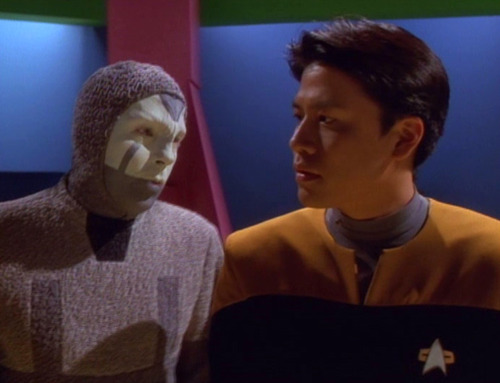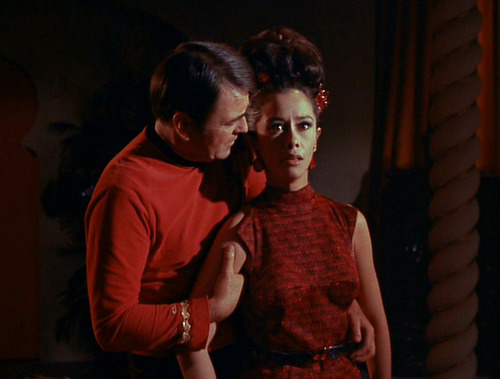“Tattoo” is a really interesting episode to look at “positive stereotyping” or “positive discrimination” as it relates to Chakotay and Native American culture. As TV Tropes defines it, positive discrimination is what happens “when the token minority character can do no wrong”:
In particular, you will virtually never see Native Americans in more recent works, without this trope being present in spades. Specifically, it’s usually a hybrid of the Magical Native American and Noble Savage tropes; the individual in question will be depicted as having a much stronger/more active connection to God or spirituality than whites are supposedly capable of, and will therefore automatically be morally superior as well, as a direct result.
I’ll return to the pitfalls of positive stereotyping a bit later but for now I’ll go through how it’s done in this particular episode.
As a side note, there’s a great subplot in this episode involving the Doctor giving himself a flu in order to better empathize with his patients. It’s worth watching for that, but I won’t be focusing on it in this entry.
The episode starts with Chakotay and an away team finding a strange symbol in the dirt on the planet:
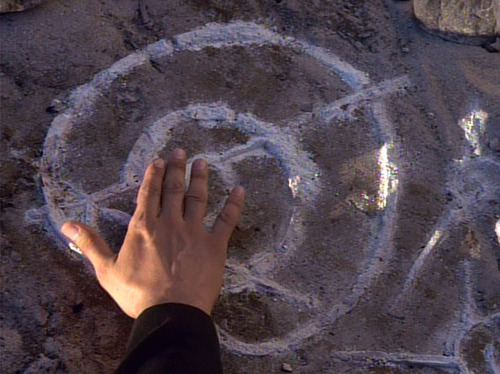
It causes Chakotay to flash back to his adolescence when his father took him on an expedition into the Central American rainforests to find descendants of their near-mythical ancestors, the Rubber Tree People.
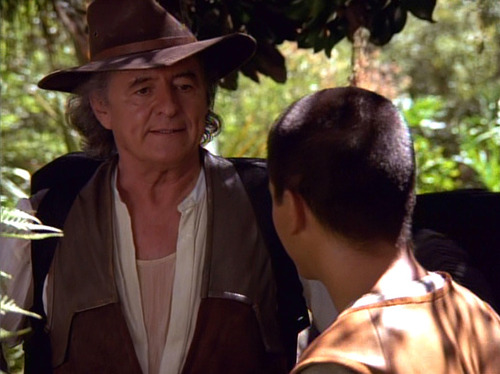
He saw the same symbol on that trip and his father, Kolopak, explained at that time it was a healing symbol for damaging the land. In these flashbacks, young Chakotay thinks this trip is very uncool. He can’t understand people choosing to live off the land and he’s skeptical that there are really any “Sky Spirits” watching over them and the Rubber Tree People.
Back on Voyager Chakotay shows Janeway the two symbols and she’s fascinated. They detect a warp trail moving away from the planet and decide to follow it. Voyager is looking for polyferranide to “seal the warp coils” so Janeway thinks the people who left the warp trail might be able to help.
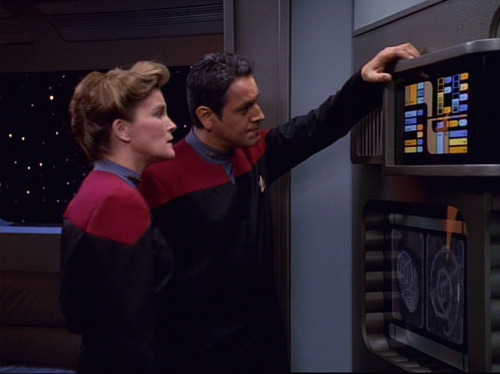
When they get to the planet, there are terrible storms stopping them from transporting down to the planet. They have to take a shuttle. The jungle they land in is very similar to Chakotay, down to the same kinds of flowers growing there as in Central America. He flashes back again to his trek with his father:
Kolopak: I take it you’ve been accepted by the Academy? Well, you’ve never fully embraced the traditions of our tribe, I know that. And you’ve always been curious about other societies, and that is why I allowed you to read about them. Because I believe that ignorance is our greatest enemy. But to leave the tribe?
Young Chakotay: Our tribe lives in the past. A past of fantasy and myth.
Kolopak: That past is a part of you, no matter how hard you try to reject it.
Chakotay snaps back to reality when Neelix contacts him. Neelix is in the middle of saying he’s found something when he’s attacked by a hawk. They beam him back to sickbay. Chakotay, Torres and Tuvok continue searching.
Then, in another flashback, Chakotay recalls actually making contact with the Rubber Tree People. Kolopak motions to his party to lay down their weapons, saying of the Rubber Tree People: “They have reason to be scared. Who can blame them? Their history, our history, is filled with conquerors who brought slavery and disease and death.”
Kolopak is able to speak some of the same language as the Rubber Tree People and they connect in that way.

On the planet the away team starts to be buffeted by inexplicable winds. They try to beam back to the ship but Chakotay gets knocked out and loses his comm badge, so the rest of the party returns without him.
When Chakotay wakes the storm has calmed. He is still trying to win the trust of the people on the planet, like his father did with the Rubber Tree People. He strips off all his clothing and stands there, naked. He sees a pair of hippie pyjamas has appeared on a nearby bench and he puts it on. He finds the entrance to a cave.
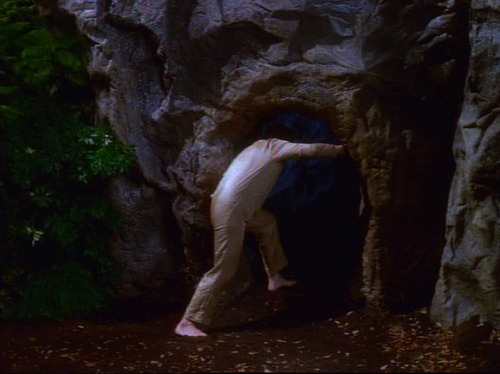
Meanwhile on Voyager, Janeway prepares to try to land the ship to go after Chakotay. As they descend they are caught in a cyclone and have ten minutes to figure out how to get out of it before the ship is torn apart.
Chakotay enters the cave and hears voices speaking the same language he once heard spoken by the Rubber Tree People – a language he never learned. Finally he remembers one word: chamozi. He speaks it and the aliens begin to step forward. They have tattoos similar to his own and he finds they visited Earth and are the “Sky Spirits” his ancestors worshipped.
At first the aliens are suspicious:
Sky Spirit/Alien: Are there others on your world with this mark?
Chakotay: Yes. Not many, but some.
Spirit/Alien: We were taught all of them had been annihilated. We were taught your world had been ravaged by those with no respect for life or land.
Chakotay: There was a time when that was true, but no longer.
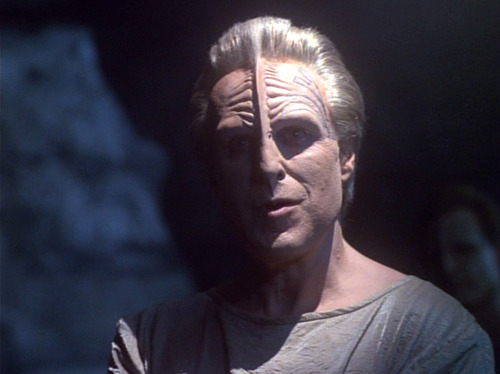
The alien explains: “45,000 years ago, on our fist visit to your world, we met a small group of nomadic hunters. They had no spoken language, no culture, except the use of fire and stone weapons. But they did have a respect for the land and for other living creatures that impressed us deeply… Hundreds of thousands of them flourished in their new land. Their civilisation had a profound influence on others of your species. But then, new people came with weapons and disease. The Inheritors who survived scattered. Many sought refuge in other societies. Twelve generations ago, when we returned, we found no sign of their existence.”
Once peaceful contact is established, the storm lets up and Voyager is freed, just in the nick of time.
Stepping out into the sun, Chakotay wishes his father was here to see this but says he died fighting to protect his colony.
Alien/Spirit: So he honoured the land just as his ancestors did.
Chakotay: Yes. Yes, he did. We weren’t on very good terms when he died. Once he was gone, I didn’t know how to reconcile our differences, how to heal our old wounds. I returned to my colony and continued the fight in his name. I took the mark that he wore to honour his ancestors. I spoke to him in my vision quests, but he never answered. Until now.

So you can see some common positive stereotypes about Native Americans in this episode: their supposed intuitiveness and spirituality, peacefulness, innate connection to nature and respect for ancestors.
The thing is, even positive stereotypes can have negative impact. An article at Psychology Today talks about a recent study in which respondents were primed with positive stereotypes about either their race or gender. They all felt depersonalized by the stereotypes. The author explains:
Stereotypes of all kinds lump an individual into a group. When you find a stereotype applied to you, it removes some of your individuality. That happens whether the stereotype used was positive or negative. It is frustrating to realize that someone views you just as a member of a group and not as an individual.
Another recent study out of Duke University found positive stereotypes can strengthen the belief that differences between races are biological, which prevents people moving beyond them.
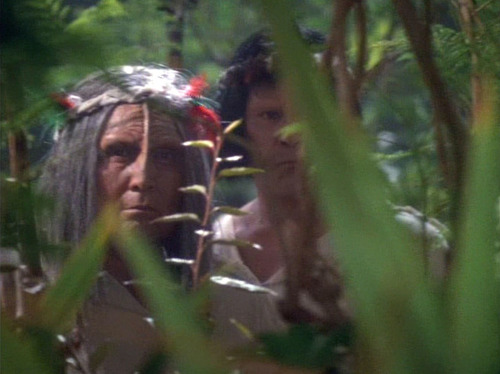
The stereotypes in this episode and the creation of a fake group of “Rubber Tree People” and “Sky Spirits: reflect an historical tendency by white people to view Native Americans as part of a single “Pan-Indian” culture, instead of recognizing the incredible diversity within and between various First Nations. And it’s not surprising that that’s what happened with an episode written and directed by white guys.
Even before this episode there were issues that reinforced Chakotay as a representative of “Pan-Indian-ness”, including many changes as to what ancestry Chakotay was supposed to have.
There’s a great article by Spiletta42 outlining all the inconsistencies in the various rituals and traits given to Chakotay through the series.
It’s clear the creators of Voyager were trying to do a good thing with Chakotay. They were trying to promote tolerance and value Native American traditions. The problem is, the way it was done didn’t help non-Native viewers learn anything real or applicable in their lives. It only reinforced stereotypes most of them were already aware of. You need to actually try to know something about the traditions and their specificities before you can value them.
And even then it’s hard to do with only one token character there to represent a vast and diverse group of people and cultures.
Bechdel-Wallace Test: Pass. Kes talks with Ensign Wildman and Janeway briefly talks to Torres.










